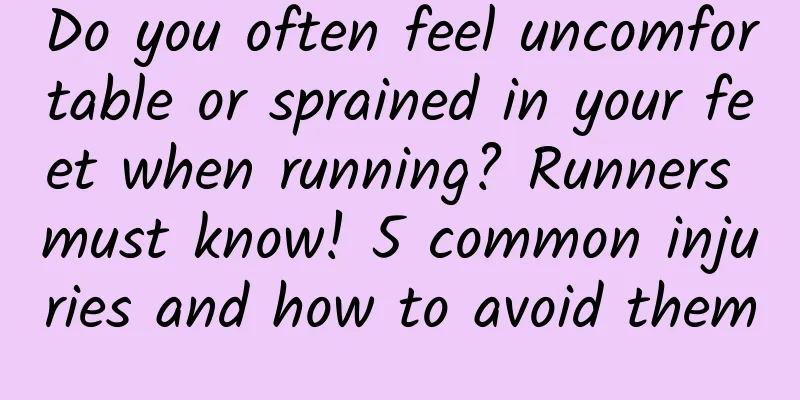Do you often feel uncomfortable or sprained in your feet when running? Runners must know! 5 common injuries and how to avoid them

|
Road running has become a part of modern people's leisure sports. Studies have shown that jogging can effectively reduce the risk of cardiovascular disease by 30%, and can also improve problems such as high blood pressure and abnormal blood lipids. While it is beneficial to health in many ways, it can also lead to overuse of the musculoskeletal system and cause injury. In the United States, for example, 37 to 56% of the 30 million road runners are injured, and approximately 2.5 to 5.5 sports injuries occur for every 1,000 hours of running, with 51% of injured men and 49.3% of injured women. Although running injuries occur about 2 to 2.5 times less frequently than other sports, statistics show that these sports injuries alone cost millions of dollars in medical expenses. Therefore, preventive education not only protects runners themselves, but also reduces medical expenses and reduces the consumption of medical resources. Spiritual Tips The origin of the marathon: In 490 BC, a soldier ran from a battlefield near Marathon in Greece to Athens, carrying the news of the victory over Persia. Eventually, the soldier died of exhaustion at the end of this historic long-distance race. Therefore, the marathon was established to commemorate this Greek soldier. The biological mechanism of road running Before explaining road running, we need to first introduce the activity mechanisms of walking and running. . walk The normal gait during walking can be divided into the stance phase and the swing phase, which account for 60% (stance phase) and 40% (swing phase) respectively. The stance phase can be divided into three parts: contact phase, mid-stance phase, and propulsion phase; the swing phase can be divided into three parts: acceleration phase, mid-swing phase, and deceleration phase. When walking, there will be a period when both feet are supporting the body at the same time. This is called the double lower limb support period. This is a necessary process for the body to shift its center of gravity when walking. . running The running gait is very different from walking. The gait during running can also be divided into the stance phase and the swing phase, but the proportion of the stance phase will decrease and the swing phase will increase. In addition, both feet will not support the ground at the same time, but the time that both feet leave the ground at the same time will increase. If there is a problem with your running gait or posture, it can cause injury or pain. The main causes of running injuries Generally speaking, there are five key factors that lead to running injuries: foot landing, knee flexion angle, hip extension angle, trunk tilt angle, and heel valgus. 1. Foot landing style There are three types of foot landing: forefoot landing, midfoot landing and rearfoot landing. It has not yet been confirmed which one is most prone to injury, but studies have shown that rearfoot landing increases pressure within the knee. Excessive use of rearfoot landing may increase the risk of injury, such as runner's knee or knee stress injuries. Conversely, forefoot landing can increase stress between the foot and ankle, causing problems such as the Achilles tendon. During training, when transitioning from the hindfoot to the midfoot or practicing forefoot landing, be careful to protect the feet and ankle joints. Do not over-train, as long-term training can easily increase the pressure on these parts. Strengthening foot training to improve stability and help runners complete training in a safe manner may help avoid these problems. 2. Knee flexion angle The knee flexion angle has a great influence on supporting the body weight during the stance phase of road running. Currently, no research has clearly established the most beneficial flexion angle for runners, but reports indicate that when supporting the body weight during the stance phase, the best shock absorption effect is achieved when the knee joint is bent at about 40 to 45°. If the knee flexion is significantly less than 40°, the shock absorption effect will be reduced, which will lead to problems such as patellar tendonitis, patellofemoral pain syndrome, and pain in the anserine muscles. 3. Hip extension angle Hip extension angle is also important during late stance. A low degree of hip extension at the end of stance can be observed in most runners, which is generally considered to be a lack of hip extension, which may be related to the reduced flexibility of the iliacus and psoas major muscles. A decrease in hip extension angle may lead to post-running injuries, including strain of the hip flexors or quadriceps. 4. Torso tilt angle Many running experts believe that the torso tilt angle is the key factor in correcting running posture. Recent studies have shown that a small increase in the forward trunk tilt angle (about 7°) can significantly reduce the pressure on the patellofemoral joint without increasing the burden on the ankle joint. This shows that this strategy is very important for runners. Overall, running with a reduced forward trunk lean (i.e., a more upright posture) was directly associated with increased knee loading. The forward lean of the trunk is not achieved purely by using the ankle joint, but by using a combination of hip flexion, pelvic tilt and small-range movements of other joints. 5. Heel valgus Heel valgus (flat feet) is one of the problems that concern the running community. Past studies have explored not only the angle of heel valgus, but also the speed of foot valgus, because the speed of heel valgus may have an important impact on specific running injuries. Studies have found that excessive heel valgus is correlated with running injuries, such as tibial stress fractures, patellofemoral pain syndrome, and Achilles tendinopathy. Therefore, adjustments to road running posture require professional guidance, training, and advice to achieve good results. This article is from How to Publish the Book "Kinesiology Taping for Performance Enhancement, Injury Prevention, and Pain Relief" |
Recommend
Can you still have sex after menopause?
Generally, you can still have sexual intercourse ...
What are the dangers of not treating cervical precancerous lesions?
I believe many people are aware of the dangers of...
How to prevent gynecological diseases
Many women suffer from gynecological diseases at ...
Cryotherapy for cervical hypertrophy
What are the treatments for cervical hypertrophy?...
Several common causes of cervical warts
According to the survey, people are very afraid o...
Analysis of the causes of irregular menstruation in modern women
For female friends, the most uncomfortable days a...
What should women with cervical erosion pay attention to in their diet? Women with cervical erosion need to pay attention to three points in their diet
Gynecologists say that it is not enough to just t...
What medicine can cure moderate inflammation of cervical erosion?
What medicine can cure moderate inflammation of c...
What are the symptoms of uterine fibroids? What can I eat to eliminate uterine fibroids the fastest?
What are the symptoms of uterine fibroids? Uterin...
What is the cause of left ovarian cyst?
What is the cause of left ovarian cyst? Left ovar...
How to treat bacterial vaginosis and the corresponding costs
When it comes to bacterial vaginosis, all female ...
Common nursing methods for patients with cervical warts
People should pay attention to the occurrence of ...
Is lower body fat better?
Lower body fat percentage does not necessarily me...
Michelle Reis's body is stunning with a set of aerial yoga
After marrying into a wealthy family, Hong Kong a...
6 foods contain excessive levels of aloesin, and Taiwan Salt is also affected
Don’t eat foods that claim to help you lose weigh...









